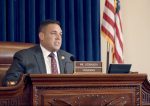Machberes: Inside The Chassidish And Yeshivish World
By Rabbi Gershon Tannenbaum
Rabbi Tzvi Elimelech Halberstam, Sanz-Klausenberger Rebbe from Netanya, arrived earlier this week in order to be with his mother, Rebbetzin Chaya Nechama, the senior Klausenberger Rebbetzin, who was hospitalized and released last week. The Klausenberger Rebbetzin lives in Union City, NJ, with her daughters, rebbetzins of Rabbi Shlomo Goldman, the Zhviller Rebbe and rav of the Sanz-Klausenburg kehillah in Union City, and Rabbi Shaul Yehuda Prizant, dayan of the Sanz-Klausenburg kehillah in Union City and roshyeshivat Shaar Efraim in Monsey.
The senior Klausenberger Rebbetzin is the daughter of Rabbi Shmuel Dovid Ungar, zt’l, Hy’d (1885-1945), Nitra Rav; son of Rabbi Yosef Moshe Ungar, zt’l (1855-1897), rav of Pistchan. She married the Klausenberger Rebbe in 1947, and gave birth to two sons and five daughters.
Anticipation intensified in expectation of the visit to the New York City greater metropolitan area. The Rebbe was received by a delegation of the leadership of Sanz-Klausenberger Torah and chesed institutions. The Rebbe went directly to Union City to be with his mother.
The Rebbe will be pouring the cornerstone for the new Sanz-Klausenberg Shul in Williamsburg, an event that will draw thousands of chassidim and highlight the dramatic growth of the Sanz-Klausenberg community, especially in Williamsburg. The highlight of the visit will surely be the Rebbe leading tefillos and tisch on ShabbosKorach, June 19-20, at the Plaza Hotel in Stamford, Connecticut. That Shabbos will be dedicated to the yahrzeit of the Rebbe’s father, Rabbi Yekusiel Yehudah Halberstam, zt’l (1905-1994), sage Klausenberger Rebbe, author of Shefa Chaim, and founder of the Laniado Hospital in Netanya. A grand melavahmalkah will be held, and tens of thousands of chassidim are expected. Additional details of the Rebbe’s itinerary are yet to be released.
During the visit, the Rebbe will have scheduled visits to Boro Park, Monsey, Williamsburg, Union City, NJ, and elsewhere. A number of receptions and fundraisers will be held in conjunction with the Rebbe’s visit.
In Israel, the Rebbe leads Torah and chesed organizations in Netanya, Ashdod, Beitar, Bet Shemesh, Bnei Brak, Elad, Haifa, Jerusalem, Modi’in, Petach Tikvah, Teverya, and Tzfas. These are in addition to Klausenberger shuls and yeshivas in Boro Park, Lakewood, Monsey, Montreal, Union City, and Williamsburg. The spiritual and financial leadership responsibilities rest upon the Rebbe’s shoulders. The present visit will be in support of those organizations, all under the banner of Sanz-Klausenberg.
Previous Plans
The Sanz-Klausenberger Rebbe had planned to come to the United States and participate in a number of events in April 2007. Unfortunately, late on isru chag Pesach in Israel, the Rebbe experienced chest pain and was brought to Laniado Hospital where he successfully underwent a procedure and was placed in the hospital’s intensive care unit. The Rebbe’s planned trip to America was postponed. The Rebbe had asked that prayers be recited for him in the ohel of his father in Netanya’s cemetery.
Rabbi Yekusiel Yehuda was the son of Rabbi Zvi Hirsh Halberstam, zt’l, (1851-1918), Rudniker Rebbe; son of Rabbi Boruch Halberstam, zt’l, (1829-1906), Gorelitzer Rebbe; son of Rabbi Chaim Halberstam, zt’l (1797-1876), venerated Sanzer Rebbe and author of Divrei Chaim.
Rabbi Yekusiel Yehuda was the son-in-law of Rabbi Chaim Zvi Teitelbaum, zt’l (1880-1926), Sigeter Rav and author of AtzeiChaim. In his second marriage, he was the son-in-law of Rabbi Shmuel Dovid Ungar (1886-1945), zt’l,Hy’d, Nitra Rav; son of Rabbi Yosef Moshe Ungar, zt’l (1855-1897), Rav of Pistchan. With his second marriage, the Klausenberger Rebbe became a brother-in-law to Rabbi Michoel Ber Weissmandl, zt’l (1903-1957), Nitra Rosh Yeshiva and author of Min Hameitzar.
The late Kalusenberger Rebbe lost his wife and 11 children, who were murdered during the Holocaust. Miraculously surviving, the Klausenberger Rebbe was a key figure in the resurgence of Torah observance amongst survivors in war-torn Europe. He established religious homes and educational institutions for orphaned children in 19 Displaced Persons camps. Every orphan boy and girl knew that a place was available for them to eat, study, learn, and live.
The Rebbe personally gave of his time to every need and request. He once took the stockings off of his own feet so that a young girl should not go barefoot. On Erev Yom Kippur, immediately after the Holocaust, a young girl asked that he take the place of her martyred father and bless her. As that became known, hundreds of orphaned girls rushed to the Klausenberger Rebbe who gave each individual girl a personal blessing, an effort that took the Rebbe all of Erev Yom Kippur.
Liberated on April 27, 1945, the Klausenberger Rebbe established in the fall of 1945, just months later, the nucleus of his efforts in the new DP camp of Föhrenwald, near Munich, which he turned into the center of religious Jewish life for all the DP camps. The Rebbe set up a kosher slaughterhouse and mikveh, distributed siddurim, tefillin, and mezuzos, and helped couples marry. He was instrumental in coordinating halachic guidelines for surviving men and women who had no standard proof of their spouse’s death, enabling them to remarry and start new families.
On Monday, Yom Kippur, September 17, 1945, General Dwight D. Eisenhower visited the camps and asked to see the Klausenberger Rebbe. The Rebbe did not receive General Eisenhower until tefillos were completed. The general asked how he could be of assistance. Exceedingly humble, the Rebbe asked for help in securing esrogim and lulavim so that survivors could properly celebrate Sukkos.
Arriving in the United States, he reestablished his chassidishe court in Brooklyn and in Union City. In 1957, the Klausenberger Rebbe founded Kiryat Sanz in Netanya, and chose to make his home there in 1960. He also established a chassidishe court in Jerusalem. The Klausenberger Rebbe was a visionary. He dreamed of and ultimately established, in 1967, the Laniado Hospital in Natanya which serves all of Israel and has one of the busiest maternity wards in the world. Mothers from across all of Israel, both religious and not yet religious, make special arrangements so that they can give birth at Laniado.
In contemplation of establishing the hospital, the Klausenberger Rebbe consulted with Rabbi Menachem Mendel Schneerson, zt’l (1902-1994), late Lubavitcher Rebbe. In reflecting upon a name, the Hebrew name for a hospital is Beth Cholim, house of the sick. The Lubavitcher Rebbe urged that, instead, the name be Beth Refuah, house of healing.
Rabbi Yekusiel Yehuda bequeathed his chassidishe dynasty to his two sons and two sons-in-law: Rabbi Zvi Elimelech serves today as Sanz-Klausenberger Rebbe in Netanya; Rabbi Shmuel Dovid as Klausenberger Rebbe in Boro Park; son-in-law Rabbi Shlomo Goldman, as Zvhiller Rebbe in Union City; and Rabbi Shaul Yehuda Prizant, Klausenberger dayan in Union City. v
Rabbi Gershon Tannenbaum is the rav of B’nai Israel of Linden Heights in Boro Park and director of the Rabbinical Alliance of America. He can be contacted at yeshiva613@aol.com.














